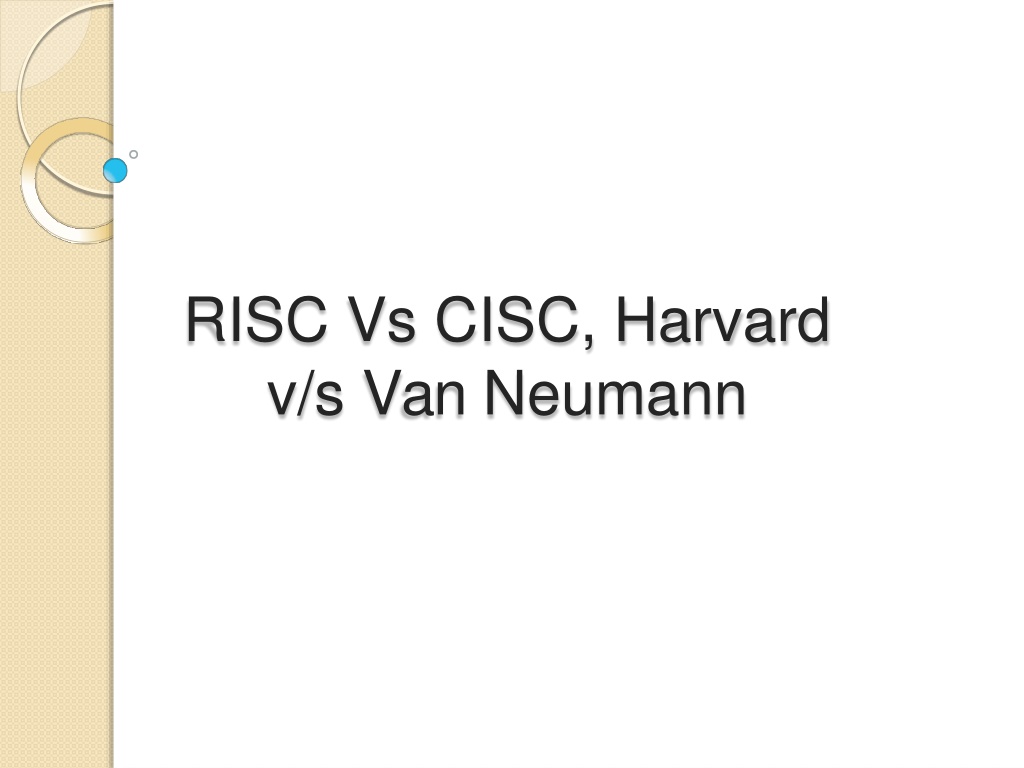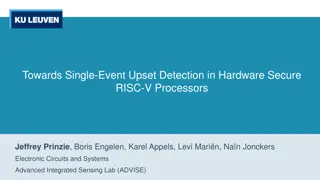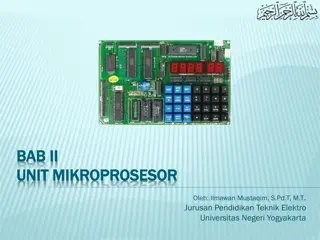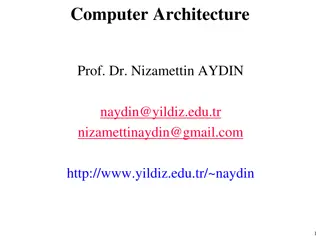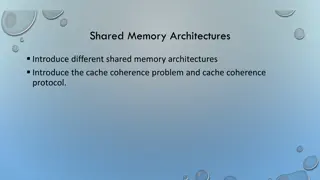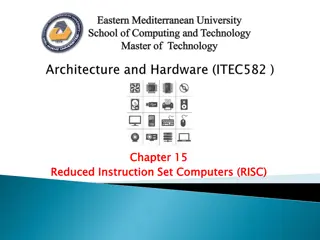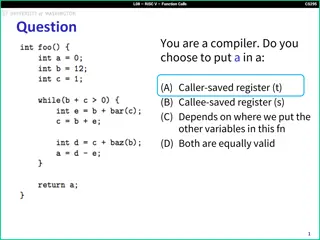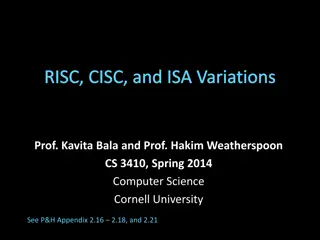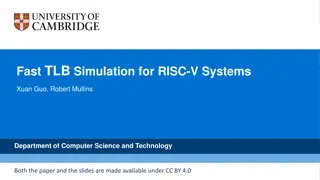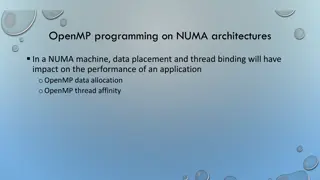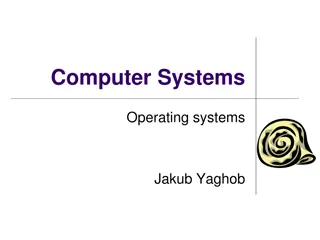Contrasting RISC and CISC Architectures
Contrasting RISC (Reduced Instruction Set Computing) and CISC (Complex Instruction Set Computing) architectures, the images and descriptions elaborate on their advantages and disadvantages, with a focus on multiplying two numbers in memory using a CISC approach. CISC processors aim to complete tasks in as few assembly lines as possible, simplifying operations for programmers. Explore how CISC processors execute complex instructions efficiently utilizing memory banks without explicit loading or storing commands.
Download Presentation

Please find below an Image/Link to download the presentation.
The content on the website is provided AS IS for your information and personal use only. It may not be sold, licensed, or shared on other websites without obtaining consent from the author.If you encounter any issues during the download, it is possible that the publisher has removed the file from their server.
You are allowed to download the files provided on this website for personal or commercial use, subject to the condition that they are used lawfully. All files are the property of their respective owners.
The content on the website is provided AS IS for your information and personal use only. It may not be sold, licensed, or shared on other websites without obtaining consent from the author.
E N D
Presentation Transcript
RISC Vs CISC, Harvard v/s Van Neumann
CISC Architecture The simplest way to advantages RISC architecture is by contrasting it with it's predecessor: CISC (Complex Instruction Set architecture. examine the of and disadvantages Computers)
Multiplying Two numbers in Memory On the right is a diagram representing the storage scheme for a generic computer. The main memory is divided into locations numbered from (row) 1: (column) 1 to (row) 6: (column) 4.
Multiplying Two numbers in Memory The execution unit is responsible for carrying out all computations. However, the execution unit can only operate on data that has been loaded into one of the six registers (A, B, C, D, E, or F).
Multiplying Two numbers in Memory Let's say we want to find the product of two numbers - one stored in location 2:3 and another stored in location 5:2 - and then store the product back in the location 2:3.
The CISC Approach The primary goal of CISC architecture is to complete a task in as few lines of assembly as possible. This is achieved by building processor hardware that is capable of understanding and executing a series of operations.
The CISC Approach For this particular task, a CISC processor would come prepared with a specific instruction (we'll call it "MULT"). When executed, this instruction loads the two values into separate registers, multiplies the operands in the execution unit, and then stores the product in the appropriate register. Thus, the entire task of multiplying two numbers can be completed with one instruction: MULT 2:3, 5:2
The CISC Approach MULT is what is known as a "complex instruction." It operates directly on the computer's memory banks and does not require the programmer to explicitly call any loading or storing functions. It closely resembles a command in a higher level language. For instance, if we let "a" represent the value of 2:3 and "b" represent the value of 5:2, then this command is identical to the C statement "a = a * b."
The CISC Approach One of the primary advantages of this system is that the compiler has to do very little work to translate a high-level language statement into assembly. Because the length of the code is relatively short, very little RAM is required to store instructions. The emphasis is put on building complex instructions directly into the hardware.
The RISC Approach RISC processors only use simple instructions that can be executed within one clock cycle. Thus, the "MULT" command described above could be divided into three separate commands: "LOAD," which moves data from the memory bank to a register, "PROD," which finds the product of two operands located within the registers, and "STORE," which moves data from a register to the memory banks.
The RISC Approach In order to perform the exact series of steps described in the CISC approach, a programmer would need to code four lines of assembly: LOAD A, 2:3 LOAD B, 5:2 PROD A, B STORE 2:3,A
The RISC Approach At first, this may seem like a much less efficient way of completing the operation. Because there are more lines of code, more RAM is needed to store the assembly level instructions. The compiler must also perform more work to convert a high-level language statement into code of this form.
The RISC Approach However, the RISC strategy also brings some very important advantages. Because each instruction requires only one clock cycle to execute, the entire program will execute in approximately the same amount of time as the multi-cycle "MULT" command. These RISC "reduced instructions" require less transistors of hardware space than the complex instructions, leaving more room for general purpose registers. Because all of the instructions execute in a uniform amount of time (i.e. one clock), pipelining is possible.
CISC RISC 1.Emphasis on software 1.Emphasis on hardware 2.Includes multi-clock complex instructions 2.Single-clock, reduced instruction only 3.Memory-to-memory: "LOAD" and "STORE" incorporated in instructions 3.Register to register: "LOAD" and "STORE" are independent instructions 4.Small code sizes, high cycles per second 4.Low cycles per second, large code sizes 5.Transistors used for storing complex instructions 5.Spends more transistors on memory registers http://cs.stanford.edu/people/eroberts/courses/soco/projects/risc/developments/index.html
Harvard Architecture The name Harvard Architecture comes from the Harvard Mark I relay-based computer. The Harvard architecture is a computer architecture with physically separate storage and signal pathways for instructions and data.
Harvard Architecture In other words, it physically separate signals and storage for code/program and data memory. It is possible to access program memory and data memory simultaneously. Typically, code (or program) memory is read-only and data memory is read- write. Therefore, it is impossible for program contents to be modified by the program itself. R.K.Tiwari(ravikumar.tiwari@raisoni.net)
Von Neumann Architecture The von Neumann Architecture is named after the mathematician and early computer scientist John von Neumann. Von Neumann machines have shared signals and memory for code and data. Thus, the program can be easily modified by itself since it is stored in read-write memory.
VAN-NEUMANN ARCHITECTURE Used in conventional processors found in PCs and Servers, and embedded systems with only control functions. HARVARDARCHITECTURE Used in DSPs and other processors found in latest embedded systems and Mobile communication systems,audio, speech, image processing systems The data and program are stored The data and program memories in the same memory are separate The code is executed serially and The code is executed in parallel takes more clock cycles There is no exclusive Multiplier It has MAC (MultiplyAccumulate) Absence of Barrel Shifter Barrel Shifter help in shifting and rotating operations of the data The programs can be optimized in The program tend to grow bigin lesser size size R.K.Tiwari(ravikumar.tiwari@raisoni.net)
Microcontrollers Embedded Systems Operations managed behind the scenes by a microcontroller Microcontroller (MCU) Integrated electronic computing device that includes three major components on a single chip Microprocessor (MPU) Memory I/O (Input/Output) ports
Microcontrollers Support Devices Timers A/D converter Serial I/O Common communication lines System Bus
Software Machine Language Binary Instructions Difficult to decipher and write Error-prone All programs converted into machine language for execution Instruction Hex 10000000 00101000 00011011 Mnemonic ADD B ADD A,R0 ABA Description Add reg B toAcc Add Reg R0 toAcc Add AccA and B Processor Intel 8085 Intel 8051 Motorola6811 80 28 1B
Software Assembly Language Machine instructions represented in mnemonics One-to-one correspondence Efficient execution and use of memory Machine-specific
Evolution of Programming Machine Language Binary format 11100101100111110001000000010000 11100101100111110000000000001000 11100000100000010101000000000000 11100101100011110101000000001000 Hexadecimal format E59F1010 E59F0008 E0815000 E58F5008
Evolution of Programming Assembly Language Mnemonic codes E59F1010 E59F0008 E0815000 E58F5008 High-Level Language C language sum = num1 + num2; LDR LDR ADD STR R1, num1 R0, num2 R5, R1, R0 R5, sum
Approaches Machine Independent Machine Dependent High-Level Languages (C, C++, Java, Pascal) Human Readable Assembly Languages Pseudo Code (Bytecode, P-code) Machine Languages (x86, MIPS,ARM) Human Unreadable
From Source to Executable Source Code ObjectCode Preprocessor Linker Libraries PreprocessedCode ExecutableCode Compiler Loader AssemblyCode Debugger Assembler
Compiler, Assembler, Linker, Cross Compiler...
Compiler A software program that converts source code that written in high level programming language into low level language. A Native-compiler runs on a computer platform and produces code for that same computer platform. A Cross-compiler runs on one computer platform and produces code for another computer platform.
Assembler Convert assembly into object file
Linker A linker or link editor is a program that takes one or more objects generated by compilers and assembles them into a single executable program or a library that can later be linked to in itself. Link the object files and libraries to form an executable
Cross-Compiler A cross compiler is a compiler capable of creating executable code for a platform other than the one on which the compiler is running. For example, a compiler that runs on a Windows 7 PC but generates code that runs on Android smartphone is a cross compiler.
Debugger A debugger or debugging tool is a computer program that is used to test and debug other programs. The code to be examined might alternatively be running on an instruction set simulator . When the program crashes, the debugger shows the actual position(Segment) in the original code if it is a source-level debugger. If it is a low-level debugger or a machine- language debugger it shows that line in the program.
Emulator An emulator is a piece of Hardware/Software that enables one computer system to run programs that are written for another computer system. For example emulator 8086, 8086 microprocessor programs. An emulator is used on the target processor (the processor for which the program is being written).
Emulator Example Android Virtual Machine(A VM)
